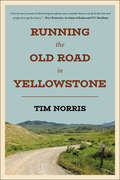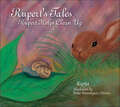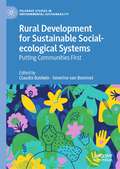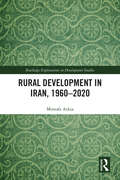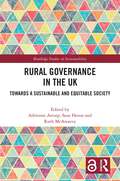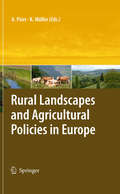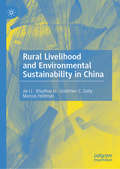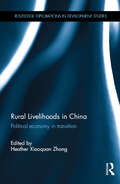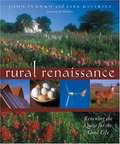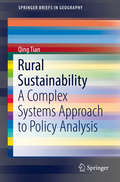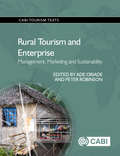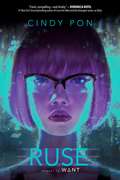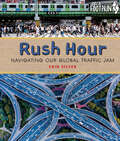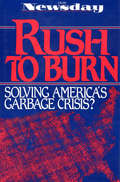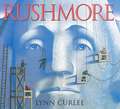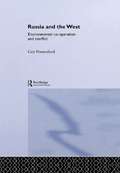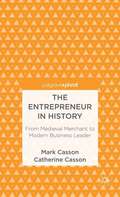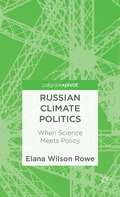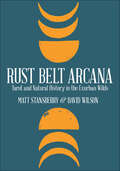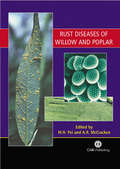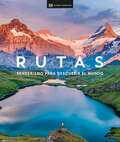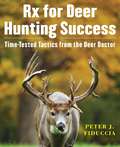- Table View
- List View
Running the Old Road in Yellowstone: One Man's Journey of Discovery and Redemption
by Tim NorrisAn inspiring and transporting book detailing one man's journey of self-realization as he spends time working and running in Yellowstone.A testament to the human spirit and the healing power of nature, Tim Norris&’ autobiographical Running the Old Road in Yellowstone is proof that running toward your problems is a lot better than running away.An avid runner with an adventurer&’s soul, Norris finds himself out of work and out of luck. When he lands a chance to work at Old Faithful in Yellowstone National Park for a summer season, the choice seems obvious: who could refuse a steady paycheck and a breathtaking natural environment, full of new running trails to explore?Set against the backdrop of one of the world&’s most magnificent natural wonders, Running the Old Road in Yellowstone shares Norris&’ journey along a trail of setbacks, switchbacks and saving graces.
Rupert's Tales: Rupert Helps Clean Up
by KyrjaRupert the rabbit is curious, furry, brown, and helpful, and it seems his lessons never end! With the help of human, animal, and fairy friends, he learns about reducing, reusing, and recycling, and how each of us has an important part to play in taking care of the world around us. A cloud of dragonflies, a singing frog, a lonely snail, a smart cat, and even a clever crow all have things to teach Rupert throughout his adventures in these four stories. Rupert's Tales are enhanced by 40 vivid pastel illustrations that create scenes sure to spark a sense of wonder at the beauty of nature. Lyrically enchanting, Rupert's adventures lovingly introduce children to the important task of fostering our natural environment.
Rural Development for Sustainable Social-ecological Systems: Putting Communities First (Palgrave Studies in Environmental Sustainability)
by Séverine Van Bommel Claudia BaldwinThis book provides an overview of interdisciplinary approaches that have applied social science to research focused on issues around food, agriculture and natural resource management. The book demonstrates that those who work in rural sociology either as researchers or practitioners apply community development and participatory techniques to socio-environmental interaction. The book discusses how the evolving concept of interconnected social and ecological systems (SES) emerged, recognizing the inherent complexity, adaptive nature, and resilience of such systems. This book engages with contemporary theory, as well as new cutting-edge transdisciplinary research evidenced in case studies from three continents.
Rural Development in Iran, 1960-2020 (Routledge Explorations in Development Studies)
by Mostafa AzkiaThis book is an authoritative account of rural development in Iran, spanning 60 years and 2 distinct political regimes.Professor Mostafa Azkia has spent many decades demonstrating the importance of participatory rural development, not only in addressing rural problems but also in reducing urban concerns, such as unemployment and overpopulation. This book is the culmination of this work, bringing together a detailed analysis of the theories, history, and strategies of rural and state development in Iran both before and after the Islamic Revolution. Putting rural communities at the fore, the book demonstrates that there has been significant progress in reducing the rural– urban gap, both in terms of income and standards of living, resulting in a more equal path of socioeconomic development for Iran.This comprehensive assessment from Iran’s foremost rural sociologist will be an important read for researchers and professionals working on rural development and sociology in the Middle East.
Rural Governance in the UK: Towards a Sustainable and Equitable Society (Routledge Studies in Sustainability)
by Ruth McAreavey Sean Heron Adrienne AttorpThis book provides a multidisciplinary analysis of rural society in a post-Brexit UK by examining the emergence of new environmental and rural policies and the implications of this transition for rural communities. Through the Common Agricultural Policy, Common Fisheries Policy, the Birds and Habitats Directives, the Water Framework Directive and a myriad of other legislations and institutions, the EU has had a deciding role in how the UK’s rural environment is governed. Disentangling this policy legacy is a complex process and offers both opportunities and challenges for policy makers, institutions, organisations and stakeholders across the UK as they strive to create appropriate new governance structures. With the Agriculture Bill, the 25-Year Environment Plan and the founding of the Office of Environmental Protection, the UK government has provided at least a degree of clarity on the future direction of environmental governance, but much remains uncertain, not least how this is engaged with by different stakeholders. While Brexit is the lens through which rural policy and sustainability are interrogated, this collection demonstrates the underpinning features of rural policy and society, identifying opportunities for addressing deep-seated policy weaknesses thereby creating a more sustainable and equitable rural society. This book brings together academics, established and early career, to discuss the impact of Brexit on rural environmental governance and on the wider sustainability of rural society, relating to three overall themes: rural governance, sustainable land use, and sustainable rural communities. In doing so, it considers sectors beyond agriculture, paying attention to social relations, community infrastructure, the environment, rural development and broader issues of land use. This book will be of interest to students and scholars of rural development, rural entrepreneurship, rural digital inclusion, environmental policy, sustainable development, land use, agrarian studies and environmental geography.
Rural Landscapes and Agricultural Policies in Europe
by Annette Piorr Klaus MüllerThe reform of the European agricultural policy aims at stimulating the development of European towards more sustainability and more competitiveness in global markets, by ensuring environmental soundness, supporting rural viability and better meeting consumers demands. Parallel to this farming in the ever growing EU is undergoing major changes. The conditions for production are occurring faster than ever, including developments such as climate change, new markets (bioenenergy), structural changes and ageing rural societies. Agriculture in an ever changing Europe has to develop multifunctional regional strategies. About 40 scientists from 11 European research institutions compiled this joint publication to provide an overview of concepts and approaches for multi functionality impact assessment, which includes surveys on societal demands in different parts of Europe. A central part presents research results on the impact of current agricultural policies and future scenarios, assessed by micro-economic and environmental modeling procedures (agent based, linear programming, trade-offs). They provide information on the issues of how and why farmers in varying structural and geophysical frameworks respond to the new CAP (Common Agricultural Policies) reform. One large chapter specifies the developments in 7 case study regions in Denmark, France, Germany, Hungary, Italy, Poland and Slovakia.
Rural Livelihood and Environmental Sustainability in China (China Connections Ser.)
by Gretchen C. Daily Jie Li Shuzhuo Li Marcus FeldmanThe book considers the challenge of poverty and deterioration of the ecological environment in China, particularly in rural areas. Examining key factors such as the overuse of natural resources and the loss of biodiversity in the face of an expanding population and rapidly developing economy. It focuses on examining the frameworks of rural households in poor mountainous areas in rural China, considering their livelihood choices and decision-making processes. It analyses the relationship between these households’ livelihoods and their environment, notably farmers’ attitudes and perceptions towards ecological conservation policies, and their use of forest resources. Cutting across the fields of population studies, sociology, economy and environment, this is an important read for scholars and students interested in how China is dealing with the challenges of natural resources exploitation, sustainable development and social welfare.
Rural Livelihoods in China: Political economy in transition (Routledge Explorations in Development Studies)
by Heather Xiaoquan ZhangIn recent decades, China has undergone rapid economic growth, industrialisation and urbanisation concomitant with deep and extensive structural and social change, profoundly reshaping the country’s development landscape and urban-rural relationships. This book applies livelihoods approaches to deepen our understanding of the changes and continuities related to rural livelihoods within the wider context of political economy of development in post-socialist China, bridging the urban and rural scenarios and probing the local, national and global dynamics that have impacted on livelihood, in particular its mobility, security and sustainability. Presenting theoretically informed and empirically grounded research by leading scholars from across the world, this book offers multidisciplinary perspectives on issues central to rural livelihoods, development, welfare and well-being. It documents and analyses the processes and consequences of change, focusing on social protection of mobile livelihoods, particularly rural migrants’ citizenship rights in the city, and the environmental, social and political aspects of sustainability in the countryside. This book contributes to the current scholarly and policy debates, and is among the first attempts to critically reflect on China’s market transition and the associated pathways to change. It will be of interest to students in international development studies, China studies, social policy, public health, political science, and environmental studies at undergraduate and postgraduate levels, as well as academics, policy makers and practitioners who are concerned with China’s human and social development in general, and agriculture and rural livelihoods in particular.
Rural Renaissance: Renewing The Quest For The Good Life
by Bill Mckibben John D. Ivanko Lisa KiviristIn the '60s it was called the "back to the land" movement, and in Helen and Scott Nearings' day, it was "living the good life. " Whatever the term, North Americans have always yearned for a simpler way. But how do you accomplish that today? Blending inspiration with practical how-to's, Rural Renaissance captures the American dream of country living for contemporary times. Journey with the authors and experience their lessons, laughter and love for the land as they trade the urban concrete maze for a five-acre organic farm and bed and breakfast in southwestern Wisconsin. Rural living today is a lot more than farming. It's about a creative, nature-based and more self-sufficient lifestyle that combines a love of squash, solar energy, skinny-dipping and serendipity . . . The many topics explored in Rural Renaissance include: "right livelihood" and the good life organic gardening and permaculture renewable energy and energy conservation wholesome organic food, safe water and a natural home simplicity, frugality and freedom green design and recycled materials community, friends and raising a family independence and interdependence wildlife conservation and land stewardship. An authentic tale of a couple whose pioneering spirit and connection to the land reaches out to both the local and global community to make their dream come true, Rural Renaissance will appeal to a wide range of Cultural Creatives, free agents, conservation entrepreneurs and both arm-chair and real-life homesteaders regardless of where they live. Lisa Kivirist and John Ivanko are innkeepers, organic growers, copartners in a marketing consulting company, and have previously published books. John is also a photographer. Former advertising agency fast-trackers, they are nationally recognized for their contemporary approach to homesteading, conservation and more sustainable living. They share their farm with their son, two llamas, and a flock of free-range chickens. Rural Renaissance also offers a foreword by Bill McKibben.
Rural Sustainability
by Qing TianThis volume applies the science of complexity to study coupled human-environment systems (CHES) and integrates ideas from the social sciences of climate change into a study of rural development amid flooding and urbanization in the Poyang Lake Region (PLR) of China. Author Qing Tian operationalizes the concept of sustainability and provides useful scientific analyses for sustainable development in less developed rural areas that are vulnerable to climatic hazards. The book uses a new sustainability framework that is centered on the concept of well-being to study rural development in PLR. The PLR study includes three major analyses: (1) a regional assessment of human well-being; (2) an empirical analysis of rural livelihoods; and (3) an agent-based computer model used to explore future rural development. These analyses provide a meaningful view of human development in the Poyang Lake Region and illustrate some of the complex local- and macro-level processes that shape the livelihoods of rural households in the dynamic process of urbanization. They generate useful insights about how government policy might effectively improve the well-being of rural households and promote sustainable development amid social, economic, and environmental changes. This case study has broader implications. Rural populations in the developing world are disproportionally affected by extreme climate events and climate change. Furthermore, the livelihoods of rural households in the developing world are increasingly under the influences of macro-level forces amid urbanization and globalization. This case study demonstrates that rural development policies must consider broader development dynamics at the national (and even global) level, as well as specific local social and environmental contexts. By treating climate as one of many factors that affect development in such places, we can provide policy recommendations that synergistically promote development and reduce climatic impacts and therefore facilitate mainstreaming climate adaptation into development.
Rural Tourism and Enterprise:
by Peter Robinson Ade OriadeMarketing and management processes across industries can be very similar, but contexts vary where political intervention, public interest and local sustainability are involved. The rural business setting is especially intricate due to the assortment of different business opportunities, ranging from traditional agriculture, to tourism enterprise and even high-tech business. This important new textbook on the subject: * Examines key issues affecting rural enterprise and tourism * Explores the breadth of rural enterprise management and marketing across both developed and developing economies * Discusses strategies for business growth within a rural setting, such as knowledge development, proper planning and innovation * Uses a mix of case studies and theoretical content specifically selected to appeal to both student and practitioner readers Including pedagogical features and full color throughout, this new textbook provides an engaging and thought-provoking resource for students and practitioners of tourism, rural business and related industries.
Rural Wit and Wisdom
by Jerry Apps Steve AppsIn an updated and expanded edition of a timeless classic, best-selling author Jerry Apps has written and collected oft-spoken phrases, observations, comments, and conundrums celebrating country life and rural living. Black-and-white photographs by Steve Apps, an award-winning photojournalist, complement the text, which offers humorous, touching, and unique glimpses into the lighter side of life in the Midwest.Jerry Apps writes novels and nonfiction about the outdoors, country life, and rural living. He received the 2008 First Place Nature Writing Award from the Midwest Independent Publishers Association and the 2007 Major Achievement Award from the Council for Wisconsin Writers. He and his wife live in Madison, Wisconsin.Steve Apps is an award-winning photojournalist with twenty-five years in the newspaper industry. As a Wisconsin State Journal staff photographer, he has covered a wide range of assignments, including the Green Bay Packers and the University of Wisconsin-Madison sports.
Ruse
by Cindy PonIn near-future Shanghai, a group of teens have their world turned upside down when one of their own is kidnapped in this action-packed follow-up to the “positively chilling” (The New York Times) sci-fi thriller Want.Jason Zhou, his friends, and Daiyu are still recovering from the aftermath of bombing Jin Corp headquarters. But Jin, the ruthless billionaire and Daiyu’s father, is out for blood. When Lingyi goes to Shanghai to help Jany Tsai, a childhood acquaintance in trouble, she doesn’t expect Jin to be involved. And when Jin has Jany murdered and steals the tech she had refused to sell him, Lingyi is the only one who has access to the encrypted info, putting her own life in jeopardy. Zhou doesn’t hesitate to fly to China to help Iris find Lingyi, even though he’s been estranged from his friends for months. But when Iris tells him he can’t tell Daiyu or trust her, he balks. The reunited group play a treacherous cat and mouse game in the labyrinthine streets of Shanghai, determined on taking back what Jin had stolen. When Daiyu appears in Shanghai, Zhou is uncertain if it’s to confront him or in support of her father. Jin has proudly announced Daiyu will be by his side for the opening ceremony of Jin Tower, his first “vertical city.” And as hard as Zhou and his friends fight, Jin always gains the upper hand. Is this a game they can survive, much less win?
Rush Hour: Navigating Our Global Traffic Jam (Orca Footprints #23)
by Erin SilverTraffic. It's not only frustrating, it's hurting the planet. Emissions from cars, buses, trucks and planes are one of the leading causes of pollution in North America. Today there are more cars clogging the roads than ever before. In Rush Hour, learn how traffic got so bad and some of the innovative ways it's being managed around the world. Discover what technological advances like talking cars and electric buses will mean for the future of traffic. Even though they can't drive yet, kids need to take control of the wheel. From walking to school, to carpooling with friends or petitioning the government, the next generation of drivers has to think differently about traffic and understand what they can do now to help protect the environment. And it starts with changing our habits, one less car ride at a time. The epub edition of this title is fully accessible.
Rush to Burn: Solving America's Garbage Crisis?
by Newsday Inc.One day in March 1987, a barge from Islip, Long Island was evicted from Morehead City, North Carolina, after trying to unload the mountains of trash on its decks. More than five months from the time it began its trip, the unwelcome barge, and it's 3,186 tons of commercial garbage, became the cornerstone of an astonishing news investigation that revealed a country unable to cope with its mounting garbage crisis. Newsday reporters were the first to locate the barge, the Mobro 4000 as it drifted aimlessly off the shore of Long Island. They were also first to explore and explain the problems and issues that barge had come to symbolize. The results of their investigation are presented in this book. Winner of the Worth Bingham Award, the Page One Award for Crusading Journalism, and the New York State Associated Press Award for In-Depth Reporting, Rush to Burn explains the reasons why we, as a throw-away society, are suffocating in our own trash. It also explains why communities, in desperation, are turning to incineration, the riskiest form of garbage disposal yet developed.
Rushmore
by Lynn CurleeThis is the fascinating story of how Gutzon Borglum, gifted sculptor and son of immigrants, overcame tremendous obstacles to create the world's most immense stone carving. Lynn Curlee's compelling narrative and stunningly composed, realistic paintings eloquently relate the monument's historical context and reveal fascinating details about its construction.
Russia and the West: Environmental Co-operation and Conflict (Environmental Politics)
by Geir HønnelandHønneland assesses current environmental discourses and applies this analysis to look at the relations between Russia and the West with regards to environment problems. It includes three in-depth case-studies on environmental problems, living marine resources, nuclear safety and air pollution.
Russian Climate Politics: When Science Meets Policy
by Elana Wilson RoweCovering the period c. 1200-c. 2000, this book provides an innovative investigation of entrepreneurship in a long-run historical perspective, presenting new insights into the personal characteristics of successful business people and deepening our understanding of the roots of industrialization and economic growth.
Russian Climate Politics: When Science Meets Policy
by Elana Wilson RoweRussia remains among the top-5 greenhouse gas emitters in the world and thus an important player in the field of international climate politics. To gain a deeper understanding of how Russian climate politics is formed, the changing and somewhat unexpected role scientists and scientific knowledge play in shaping Russian policymaking is explored.
Rust Belt Arcana: Tarot and Natural History in the Exurban Wilds
by David Wilson Matt StansberryAn insightful take on the Tarot through the lens of the industrial Midwest, and a beautiful piece of nature writing in its own right. What can the Tarot tell us about the flora and fauna of the industrial Midwest? In what ways might this ancient practice connect us to the Rust Belt today? Rust Belt Arcana uses the Tarot&’s time-tested structure to answer these questions, juxtaposing the characteristics of the cards with the creatures and plants that surround us every day. The twenty-two idiosyncratic essays here—one for every card in the Major Arcana—bridge biology, natural history, and the human condition. They tell stories of abundance and loss, and they remind us of the Rust Belt&’s persistent remnant wilderness, a landscape often dismissed as unremarkable. A magical book both for Tarot enthusiasts and for those who are seeking to see beauty in a beleaguered landscape and define their remarkable place within it. &“Original and insightful. A vivid exploration of the beauty and brokenness of life&’s community. Stansberry&’s writing reveals the many surprising ecological, psychological, and cultural connections among human and beyond-human lives.&” —David George Haskell, Pulitzer finalist for The Forest Unseen &“A surprising, delightful book, filled with original insights about the rich diversity of nature in the Midwest. Highly recommended!&” —Kenn Kaufman, author of Kingbird Highway &“The essays in Rust Belt Arcana are like meditations from a parallel world —a magical place of nature which persists against all odds alongside the cities and subdivisions and highway interchanges of the Great Lakes region.&” —David Beach, GreenCityBlueLake Institute, Cleveland Museum of Natural History
Rust Diseases of Willow and Poplar
by Ming Hao Pei Alistair R. MccrackenThere is increased interest in growing willow and poplar trees, as fast-growing species that have several purposes, including use as biofuels for energy production. However, silviculture is constrained by diseases such as Melampsora rusts, which have been extensively studied over the past two decades. As a result, they are now one of the best-understood tree pathogens in terms of population biology, genetics of resistance and disease control using host-genotype mixtures. This book is the first to provide a comprehensive review of our knowledge of rust diseases of willow and poplar.
Rutas (Hike): Senderismo para descubrir el mundo
by DK Eyewitness* Incluye mapas y perfiles de altitud.* Abarca 125 recorridos, desde sencillas caminatas de un día hasta grandes travesías.* Incluye la ruta del Camino de Santiago y la Garganta del Cares.* Cada capítulo explora un continente diferente.125 rutas para descubrir el mundo.Es hora de calzarse las botas y emprender una gran aventura. Asciende montañas, explora la costa o atraviesa densos bosques. Este libro te invita a recorrer las 125 rutas de senderismo más pintorescas y espectaculares del mundo y te ofrece información para todo tipo de recorridos, desde suaves paseos de un día hasta épicas marchas de larga distancia. Encuentra toda la inspiración para explorar el mundo a pie.—------------* Includes maps and elevation profiles.* Covers 125 hikes, from straightforward day walks to epic cross-country treks.* Each chapter covers a different continent.Compiled by a team of outdoor enthusiasts, this book is packed with ideas for your next hiking trip. Awe-inspiring images and compelling descriptions of each trail will have you itching to get walking, while handy maps, elevation profiles, and practical information. Hike is your ticket to the adventure of a lifetime.
Rx for Adventure: The Story of an Alaska Bush Pilot Doctor
by Naomi Gaede-Penner Elmer GaedeAfter driving up the Alaska-Canada Highway with her family at age five, Naomi Gaede-Penner spent many of her formative years in the land of Indians and Eskimos, the Yukon River, tundra, dogsleds, the midnight sun and -70 degrees F. A lasting impression from those years is her father's suppertime storytelling. Those stories were about medical emergencies, bush flying hazards, and hunting adventures.
Rx for Deer Hunting Success: Time-Tested Tactics from the Deer Doctor
by Peter J. FiducciaThis ground-breaking book is loaded with new scientific research that will help you become a better deer hunter.This comprehensive guide provides a compilation of in-depth coverage on all methods used to hunt whitetail deer consistently and successfully. Fiduccia’s real-world hunting strategies will benefit both the novice and the veteran deer hunter. Each chapter is specifically designed to provide readers with enhanced skills through innovative tips, as well as strategies to help take their deer hunting success to the next level.Many of the chapters include information rarely seen in print before. Fiduccia shares his five decades of whitetail hunting wisdom and experience in a manner that is easy to understand and apply. His tactics combine time-tested hunting strategies with the most up-to-date scientific research on white-tailed deer. Anyone who reads The Deer Doctor’s Rx to Whitetail Hunting Success will gain the edge in becoming a more effective deer hunter.Skyhorse Publishing is proud to publish a broad range of books for hunters and firearms enthusiasts. We publish books about shotguns, rifles, handguns, target shooting, gun collecting, self-defense, archery, ammunition, knives, gunsmithing, gun repair, and wilderness survival. We publish books on deer hunting, big game hunting, small game hunting, wing shooting, turkey hunting, deer stands, duck blinds, bowhunting, wing shooting, hunting dogs, and more. While not every title we publish becomes a New York Times bestseller or a national bestseller, we are committed to publishing books on subjects that are sometimes overlooked by other publishers and to authors whose work might not otherwise find a home.
Río hacia la nada
by Pureza CaneloNavega la velaen el agua del río sin fin.La corriente ensancha su trayecto:es el punto de luz del corazónque abarca un horizonte no visible,más allá del horizonte.
